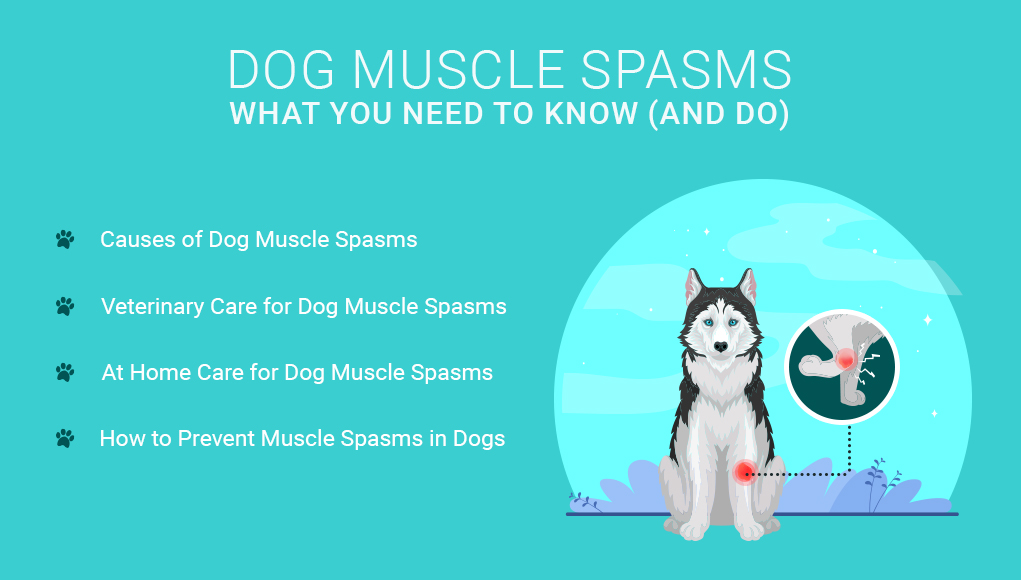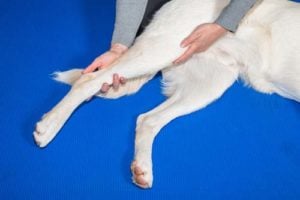Table of Contents
- Dog Muscle Spasms: What You Need to Know (and Do)
- The Root Causes of Dog Muscle Spasms
- Spotting the Signs: Symptoms of Muscle Spasms in Dogs
- Veterinary Care for Dog Muscle Spasms
- At Home Care for Dog Muscle Spasms
- How to Prevent Muscle Spasms in Dogs
- Common Questions about Muscle Spasms in Dogs
- What Can I Give My Dog for Muscle Spasms?
- Why Is My Dog Twitching All of a Sudden?
- What Does It Mean When a Dog Starts Twitching?
- How Do You Stop a Dog from Having Muscle Spasms?
- Can Dehydration Cause Muscle Spasms in Dogs?
- How Much Does It Cost to Treat Muscle Spasms in Dogs?
- Are Some Breeds More Likely to Shake than Others?
Imagine your furry companion suddenly experiencing a series of involuntary muscle movements, leaving you both puzzled and concerned.
What could be behind these mysterious spasms, and how can you help your four-legged friend?
Look no further, as we dive deep into the world of dog muscle spasms and uncover their causes, from simple injuries to complex neurological disorders.
Just like humans, your dog may encounter muscle spasms due to localized issues, like a hurt leg.
However, spasms are also caused by a misfiring of the nervous system.
This particularly happens in your dog's brain, where voluntary and involuntary movements are regulated.
As a result, some conditions that trigger dog muscle spasms are closely linked to neurological disorders, often leading to seizures.
Seizures in dogs, whether epileptic or non-epileptic, consist of numerous recurring muscle spasms, with their origin tied to electrical activity in the brain.
But don't fret just yet!
Dog muscle spasms can and do happen outside of seizures, meaning it's a less severe health concern.
To guarantee your dog's well-being, pinpoint the exact cause of their muscle spasms before attempting any treatments.
In this guide, I'll walk you through everything you need to know about dog muscle spasms and how to address them effectively.
ALSO READ: Epileptic Seizures in Dogs – Symptoms and Treatments
Dog Muscle Spasms: What You Need to Know (and Do)
The Root Causes of Dog Muscle Spasms
When our dogs experience muscle spasms, it's natural for us to worry and wonder what could be causing them.
There's no single answer, as the underlying reasons for muscle spasms can be quite diverse.
Let's dive into some of the most common causes to help you better understand what might be happening to your pup.
1. REM Cycle Twitching
If you observe muscle twitching while your dog is asleep, there’s likely nothing to be concerned about.
During the REM cycle, your dog's deepest sleep is achieved.
During this time, the animal's brain experiences a higher level of activity, which could explain why some dogs (and people) often twitch in their sleep.
Research has proven that dogs dream, so they’re probably just chasing a squirrel around in dreamland; however if you suspect this is an adverse cause (like a seizure), attempt to wake your pet up carefully.
If it isn’t a seizure, they’ll jolt right awake, but if they are experiencing a non-epileptic seizure, they’ll be much more difficult to awaken.
2. Injury
Dogs‘ muscles, bones, veins, nerves, and cartilage all come together to form a complex system, which is why issues with muscles often coincide with or cause joint problems, just as worn cartilage can lead to muscle wasting or atrophy.
When the dog's body experiences a damaged joint or muscle, the muscles surrounding it will cramp or stiffen, which can look like spasms and typically cause the dog to limp or change its gait.
Additionally, head trauma which affects the brain’s ability to calibrate limb movement, could lead to dog muscle spasms.
3. Hypoglycemia
Although a rare side effect, low blood sugar in hypoglycemic canines may cause muscle spasms and seizures.
It's very uncommon, but sometimes diabetic dogs will experience muscle twitching and similar dog muscle spasm condition symptoms.
4. Overexertion
When a dog plays or runs a little too hard or too long, its muscles can suffer from heavy activity.
Lactic acid, naturally produced by the overexerted muscle tissue, builds up and creates soreness and cramps in the dog's body, just as it does in humans.
Fatigued, your pet's muscles will twitch, but this will typically subside on its own and relatively quickly.
Time spent outdoors without water, in addition to running or playing, will cause severe dehydration or heat stroke in dogs, which are also associated with seizures.
5. Toxicity
Toxicity is another word for poisoning and is common in dogs as they tend to sniff out items not intended for their consumption.
Wobbling is a defining characteristic of canine toxicity but could be mistaken by pet owners to be dog muscle spasms.
If gone without treatment, poisoning in dogs can lead to kidney failure and the nervous system's over-activity, which both cause seizures in dogs.
6. Distemper
This is a well-known contagious virus that affects puppies and dogs without up-to-date vaccines and may result in symptoms like dog muscle spasms.
Canine distemper can be spread in various ways, making it extremely easy for an unaffected dog to become infected.
The dog doesn’t even have to interact closely with an infected animal to contract the distemper virus.
For this reason, doggie hotels, rescue organizations, and kennels always require up-to-date vaccinations of your pup, as even contact with a canine suffering distemper’s bedding or food bowl will spread distemper virus if not disposed of.
An infected animal with viral contagion is dangerous to other dogs even before they begin to show symptoms.
Canine distemper virus affects the dog's nervous and respiratory systems, among other organs.
In particular, the virus's attack on the canine's nervous system is what causes seizures.
It can lead to paralysis, dog muscle spasms being just a transitional period before more serious symptoms appear.
7. Dystonia
A condition rarely talked about; dystonia may be inherited or developed within dogs and severe neurological disorder.
Its most common and recognizable symptom is chronic, involuntary (sometimes disabling) dog muscle spasms.
A pet with dystonia is likely to experience anxiety and depressive disorders, often due to constant discomfort caused by the muscle twitching and contracting.
8. Canine Stress Syndrome (CSS)
Canine Stress Syndrome is a neurological disorder that certain breeds, such as Labrador Retrievers, are susceptible to.
CSS is an uncommon yet hereditary condition and may only show symptoms due to psychological stress, sometimes referred to as hyperthermia syndrome in dogs.
Studies have shown that over-exercising dogs can also induce it, and it can be successfully treated if done in time and aggressively.
Canine stress syndrome symptoms include anxiety, hyperthermia, and involuntary dog muscle spasms, as well as severe seizures.
9. Metabolic imbalances:
Imbalances in your dog's electrolyte levels can cause muscle spasms.
Electrolytes are minerals like calcium, potassium, and sodium, which help regulate muscle function.
Conditions such as kidney disease, thyroid disorders, or dehydration can lead to electrolyte imbalances and subsequent muscle spasms.
It's important to note that this list is not exhaustive, and other factors may contribute to muscle spasms in dogs.
As a responsible pet owner, it's essential to keep a close eye on your dog's overall health and behavior.
If muscle spasms persist or worsen, it's always a good idea to consult your veterinarian for a thorough evaluation and appropriate treatment plan.
In the book “Canine Neurology: A Comprehensive Guide,” Dr. Jennifer Coates explains that muscle spasms in dogs can be an early warning sign for more serious issues.
This emphasizes the importance of understanding what's happening with your dog's health and taking appropriate action.
Spotting the Signs: Symptoms of Muscle Spasms in Dogs
Now that we've covered some of the most common causes of muscle spasms in dogs, it's time to learn how to recognize the signs and symptoms.
Being able to identify muscle spasms early on can make a world of difference in ensuring your dog gets the appropriate care and treatment.
Here are some key indicators to watch for:
1. Involuntary muscle movements
The most obvious sign of a muscle spasm is the sudden, involuntary contraction of a specific muscle or group of muscles.
This may cause your dog to twitch, jerk, or tremble without any apparent reason.
2. Localized pain or discomfort:
If your dog is experiencing a muscle spasm due to an injury, they may show signs of pain or discomfort in the affected area.
This could include limping, favoring one leg over another, or vocalizing when touched.
3. Stiffness and reduced mobility:
Muscle spasms can cause stiffness and limit your dog's range of motion.
You might notice your dog struggling to move or hesitating before performing activities they would normally enjoy, such as jumping or running.
4. Behavioral changes:
Dogs experiencing muscle spasms may exhibit changes in their behavior.
They might become more irritable, anxious, or lethargic than usual.
Keep an eye out for any sudden or unexplained shifts in your dog's demeanor.
5. Prolonged or recurrent spasms
If your dog's muscle spasms are persistent or recurring, it's essential to seek veterinary attention.
This could be a sign of a more serious underlying issue that requires professional evaluation and treatment.
6. Changes in gait or posture
Muscle spasms can alter your dog's gait or posture, making it difficult for them to move naturally.
Keep an eye out for any sudden changes in the way your dog walks, stands, or carries their body, as this could be an indication of muscle spasms.
7. Muscle swelling or inflammation
In some cases, muscle spasms can cause the affected area to become swollen or inflamed.
If you notice any unusual swelling or redness on your dog's body, it's important to consult with your veterinarian to determine the underlying cause.
In “The Dog Owner's Home Veterinary Handbook,” Dr. James M. Giffin emphasizes the importance of monitoring your dog's health and seeking veterinary care when something seems amiss.
As a responsible pet owner, being vigilant about your dog's well-being is crucial for maintaining their overall health and happiness.
Veterinary Care for Dog Muscle Spasms
Unless you’re uncertain whether the dog muscle spasms are no more than isolated twitching (such as a dog involuntarily moving while asleep – see above), contact your veterinarian immediately.
You should especially seek an appointment if the spasms are constant and paired with vomiting or immobility.
At the vet’s office, you’re likely to be asked a series of questions as well as provide your animal’s medical history.
If epilepsy or any other neurological disorders are suspected, the vet and their staff will utilize Electroencephalogram (EEG) testing to observe and record the dog's brain's electric activity.
If diagnosed with epilepsy, the vet will discuss dog antiepileptic drug therapy, which seeks not to cure the disorder but to stabilize the dog and reduce their seizure threshold as much as possible, therefore allowing them to lead a relatively normal life.
The staff may suspect that the muscle spasms is a result from poisoning, they will give your pet injections to induce vomiting (typically a drug called Apomorphine).
They may also choose to utilize IV fluids to flush any toxicity from the dog's major organs.
Whenever dog muscle spasms or seizures are present, veterinarian staff will run blood work to check enzyme levels of important internal organs.
Other laboratory testing may include analysis of the urine, fecal matter, as well as spinal fluid.
If a limp is present or you share information of a recent fall or other injuries, they’ll take x-rays and/or CT scans.
For non-epileptic episodes in dogs, the veterinarian may prescribe an anticonvulsant medication to be taken for a trial period, determining the pet’s responsiveness to the drug.
The staff is also likely to suggest changing your dog’s diet, replacing kibble full of chemicals and food dyes with all-natural ingredient-based meals.
An elimination diet may be recommended, and most common foods for dogs with muscle spasms will usually be more holistic, organic human-grade, and the vet recommended brands.
At Home Care for Dog Muscle Spasms
With a diagnosis and advice from your dog’s veterinarian, you can now take the proper steps to alleviate discomfort and possibly even stop dog muscle spasms from occurring in the future.
Here are a few things you can do while dog muscle spasms are occurring:
Gently massage and pet your dog.
Gentle pressure to a tight or inflamed muscle will help alleviate tenseness. Less tension means muscle spasms are less likely to occur again. There are several pet massage techniques and types that you can utilize.
Apply a cold compress
Icing an injured muscle restricts the blood vessels, helping ease inflammation and lowering the likelihood of current and future dog muscle spasms and related symptoms.
Remain calm and stay focused
Whether your dog is experiencing non-chronic muscle spasms or has been diagnosed with a seizure condition, it’s important to note that they are often not conscious during these events.
While it may be scary for you to witness, you can find comfort in the fact that they don’t have to experience first-hand mentally.
Another comforting fact for pet owners is that spasms and/or seizures in dogs typically only last at most 60-80 seconds and at least 10 to 30 seconds.
Dog seizures lasting five minutes or longer are considered life-threatening and are rare.
Although not ideal, dogs suffering from conditions that may cause mild to severe muscle spasm fits are perfectly capable of living long, happy lives when given the proper care and/or medication.
Knowing this will help you remain calm should they experience a fit, which helps them stay calm and makes the experience less frightening for everyone involved.
How to Prevent Muscle Spasms in Dogs
Ensure your dog stays hydrated
Dehydration can exacerbate dog muscle spasms. Always keep a cool and full water bowl both in your yard and in the home. For senior dogs, or animals recovering from an injury that makes getting around more difficult, place water bowls in multiple locations around the house so they don't have to travel far.
Chaperoning playtime with other dogs
Watch carefully when your dog interacts with others, whether at the dog park or in your own backyard with a dog they know very well. Chaperoning your pet’s social life will better your chances of observing injury or the potential for injury at the moment it occurs.
Know the signs
Knowing how an animal acts moments before a seizure occurs will help you prepare for future dog muscle spasm attacks. The most common four signs are:
- Anxiousness
- Staggering
- Disorientation
- Excessive licking and/or pacing (a sign of nervousness)
READ NEXT: 5 Things to Do If Your Dog Is Paralyzed
Common Questions about Muscle Spasms in Dogs
If you still have lingering questions about muscle spasms in dogs, the following FAQs should help clear them up for you.
What Can I Give My Dog for Muscle Spasms?
You should always consult your dog’s vet before giving him medicine for muscle spasms. Some of the most common options include methocarbamol and diazepam. Methocarbamol is beneficial with muscle spasms from IVDD. Diazepam not only acts as a muscle relaxant but also calms your pooch.
Why Is My Dog Twitching All of a Sudden?
Muscle spasms aren’t the only potential reason for your dog twitching. He may also experience injuries, muscle strains, or other malfunctions that lead to ticks or tremors beneath your dog's skin. Myoclonus, a muscle contraction disease, is one potential cause. A thiamine deficiency is another potential cause. Physical injury or a pinched nerve can also cause muscle spasms in dogs.
You should always consult a vet for veterinary treatment. This is to ensure that the cause of the muscle contractions is not life-threatening. Your vet will check the pup's spinal cord and hind legs. In addition, they will search for neurological damage and physical injuries. He will find the underlying cause and confirm no serious issues like muscle damage or a slipped disc. Expect him to check for degenerative myelopathy, nerve damage, a pinched nerve, and physical injury. And they will check additional issues outside of the affected body part. He will also ask about lameness, depression, pain, or other issues related to the dog's muscle spasms. Different recent injuries can cause similar tremors, so this diagnosis is important.
What Does It Mean When a Dog Starts Twitching?
Your dog twitching can be due to a medical cause, such as in the case of muscle contractions. If he is asleep, he may be twitching in his sleep. You can typically tell the difference between a dog’s muscle spasms or seizures and movements in a dream. Expect dreaming movements to last half a minute or less and be intermittent. This is normal muscle contraction. By contrast, if your dog is seizing, the movement will be more violent, and his limbs will be stiff and rigid. Either situation could be involuntary muscle movements.
How Do You Stop a Dog from Having Muscle Spasms?
You can use the above home remedies and veterinary treatments to reduce or prevent muscle spasms. Your dog’s vet will help you develop a plan that will likely include regular myotherapy sessions. A vet will treat the root cause of the issue after a proper diagnosis. Your vet may also suggest a more supportive diet, cold therapy, exercises or medicines to help with nerve function or physical therapy. They may tell you to stretch your dog's limbs gently. Treatment will also depend on your dog's fitness levels.
If you notice further spasms or muscle strain in the affected dog, contact your vet for additional treatment and further tests. Hopefully, you can avoid muscle spasms in the future for a long period.
Can Dehydration Cause Muscle Spasms in Dogs?
Yes, dehydration can be a cause. That is because a dog's muscular system needs water to function. Without it, they aren’t able to contract properly. Luckily, it is easy to prevent dehydration-related spasms as you need to ensure your dog always has access to enough fluids. This is especially important after physical activity or if you notice your dog's skin is dry.
How Much Does It Cost to Treat Muscle Spasms in Dogs?
The cost of treatment will depend on what your vet suggests. You can typically buy your canine companion electrolytes for about $10 to $24. Costs of medication, recent sprains, and other treatments vary. If you pay for a professional doggie massage, an hour will typically cost $55 to $75.
The overall cost for proper treatment depends on numerous factors. These including the affected nerve, the affected muscles, which muscle relaxants your vet suggests. You can use herbal muscle relaxers or pain relievers if there is a muscle injury.
If there is physical damage, notice other symptoms are present, whether there are localized twitches and your pup's associated pain.
Expect extreme cases cost more to treat. Especially if the other symptoms have been at the affected area for a while and your dog is in pain.
Are Some Breeds More Likely to Shake than Others?
Certain dog breeds have a higher chance of tremors than others, with or without pain or additional symptoms. These include Weimaraners, springer spaniels, Samoyeds, Labradors, English bulldogs, Dalmatians, Doberman pinschers, and chow chows. These breeds still need to see the vet for issues with a dog's muscular system, including localized twitches and pain.


















